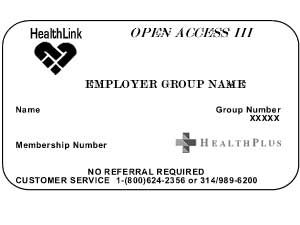September 13, 2005
 |
| If you have a health insurance card in your wallet, you're far more likely to get timely followup medical care than if you don't have coverage. That's the conclusion of a new study released Tuesday. (Image courtesy of HealthPlus, Peoria, Ill.) |
St. Paul, Minn. — The HealthPartners study examined access to followup appointments at 430 clinics in nine U.S. cities, including Minneapolis and St. Paul. Researchers called the clinics pretending to be patients. These fake patients told the clinic staff they had just been seen in an emergency room and needed an urgent followup appointment with a doctor within one week.
The patient callers were instructed to describe one of three predetermined ailments, all of which are serious. One was extremely high blood pressure, the second condition was pneumonia. The third was a possible ectopic pregnancy, when a fetus implants in a woman's fallopian tubes or outside of the uterus. It's a life-threatening condition.
Dr. Brent Asplin, the study's author, says each clinic was called twice by the same caller who described the exact same medical problem each time. The only difference between the calls was the patient's insurance status. But Asplin says that difference had a significant effect.
"Privately insured callers in our study had an overall appointment rate of 64 percent, got an appointment within one week of reportedly leaving the emergency department," says Asplin. "That was compared to only 34 percent of callers who claimed to have Medicaid coverage, and only 25 percent of those who stated they were uninsured but were only able to pay $20 at the time of appointment."
"It is wrong. This whole thing is wrong," says Dr. Mary Frank, president of the American Academy of Family Physicians. "For medical decisions to be made on the basis of a payer source is wrong. It just shouldn't be. I understand the economic pressures on physicians, but this is wrong."
Frank says she's not suggesting that physicians take in every patient who can't pay their bill, because that's not a smart way to run a business. But she does wonder if some doctors have forgotten their oath to take care of people.
The outlook for Medicaid patients was least gloomy in the Twin Cities. Those patients were able to book timely appointments 64 percent of the time at Minneapolis and St. Paul clinics. That's nearly twice the study average.
Brian Osberg, assistant commissioner of the Minnesota Department of Human Services, says it appears that Medicaid patients are more welcome in Minnesota clinics.
"That probably is because physicians in this state have stepped up and been willing to serve our Medicaid clients in a way that I think has been very beneficial to our clients. So this maybe bears that out," says Osberg.
It is possible that Minnesota physicians get paid more for Medicaid patients than doctors in other states. But Osberg says he doesn't know if that's the case, since payments are privately negotiated between doctors and the Minnesota insurers who manage the state's Medicaid program.
That good news is still tempered by the fact that Twin Cities clinics didn't fare well at all when it comes to accommodating patients with no insurance. Just under 22 percent of uninsured callers were able to get an appointment within a week, compared to the study average of 25 percent.
But study author Brent Asplin says that doesn't mean that patients without insurance can't get better results.
"I think the most important recommendation I would make is to be persistent," says Asplin. "We certainly sometimes had to make several calls to try to get an answer, and I would look for all the possible resources you can."
When asked about which resources he's talking about, Asplin said there are low-cost clinics that are more willing to take patients without insurance. He also recommended health insurance for anyone who's eligible for a government subsidized program, but not yet signed up.
Beyond that, Asplin says there's little that's likely to improve access to clinics without a more significant change in the way health care is paid for in the U.S.




